History
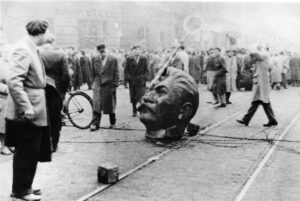 Those who support Socialism, Marxism, and Communism have simply never lived under these forms of government, or they are a part of the upper echelon of such a government. People who have been forced to live under these types of government, will ultimately try to find a way of escape or will participate in a national uprising, such as the one that happened in Hungary in 1956.
Those who support Socialism, Marxism, and Communism have simply never lived under these forms of government, or they are a part of the upper echelon of such a government. People who have been forced to live under these types of government, will ultimately try to find a way of escape or will participate in a national uprising, such as the one that happened in Hungary in 1956.
Sadly, by the time the people realize that they are in serious trouble, the government often has such a chokehold on the nation that the only way out if to have an uprising. Nevertheless, people will eventually fight for their rights, or fight to escape. While the uprising in Hungary began in October 1956, when thousands of protesters took to the streets demanding a more democratic political system and freedom from Soviet oppression, the real problem started long before that. It started when the Communist Party took over and began to systematically take away the rights of the people. There were a few people within the party who could see through the Communist Party’s ideas. When party officials appointed Imre Nagy, a former premier who had been dismissed from the party for his criticisms of Stalinist policies, as the new premier, he began to try to restore peace and asked the Soviets to withdraw their troops. The Soviets did so, but Nagy then tried to push the Hungarian revolt forward by abolishing one-party rule. He also announced that Hungary was withdrawing from the Warsaw Pact (the Soviet bloc’s equivalent of NATO).
This forced the hand of the Soviet government. On November 4, 1956, Soviet tanks rolled into Budapest to 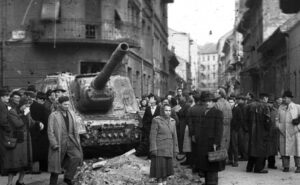 crush the national uprising, once and for all. Te fighting in the streets was vicious, but the Soviets’ greater power ensured their victory. The people had long been stripped of their weapons, and anything else that might have helped the achieve victory. At 5:20am Hungarian Prime Minister Imre Nagy announced the invasion to the nation in a grim, 35-second broadcast, declaring: “Our troops are fighting. The Government is in place.” He tried to reassure the people and keep hope alive, but within hours, Nagy sought asylum at the Yugoslav Embassy in Budapest. He was captured shortly thereafter and executed two years later. Nagy’s former colleague and imminent replacement, János Kádár, who had been flown secretly from Moscow to the city of Szolnok, 60 miles southeast of the capital, prepared to take power with Moscow’s backing. The conspiracy was complete, and the people had been betrayed…even their leader.
crush the national uprising, once and for all. Te fighting in the streets was vicious, but the Soviets’ greater power ensured their victory. The people had long been stripped of their weapons, and anything else that might have helped the achieve victory. At 5:20am Hungarian Prime Minister Imre Nagy announced the invasion to the nation in a grim, 35-second broadcast, declaring: “Our troops are fighting. The Government is in place.” He tried to reassure the people and keep hope alive, but within hours, Nagy sought asylum at the Yugoslav Embassy in Budapest. He was captured shortly thereafter and executed two years later. Nagy’s former colleague and imminent replacement, János Kádár, who had been flown secretly from Moscow to the city of Szolnok, 60 miles southeast of the capital, prepared to take power with Moscow’s backing. The conspiracy was complete, and the people had been betrayed…even their leader.
The people of the West were stunned by the Soviet action. Soviet leader Nikita Khrushchev had promised to retreat from the Stalinist policies and repression of the past, but the violent actions in Budapest told of a different plan. An out of control government will always chose its own greedy ways over the good of the people it is supposed to serve. On that day, an estimated 2,500 Hungarians died and 200,000 more fled as refugees. Sporadic armed resistance, strikes, and mass arrests continued for months thereafter, causing substantial economic disruption. The spontaneous national uprising that began 12 days before in Hungary was viciously crushed by Soviet tanks and troops on November 4, 1956.

Many Hungarians were angered and frustrated by the inaction on the part of the United States. Voice of America radio broadcasts and speeches by President Dwight D Eisenhower and Secretary of State John Foster Dulles had recently suggested that the United States supported the “liberation” of “captive peoples” in communist nations, but they didn’t see that playing out in their situation. During that time, approximately 30,000 Hungarian refugees were allowed to enter the United States. Yet, as Soviet tanks bore down on the protesters, the United States did nothing beyond issuing public statements of sympathy for their plight.
 Politics is always a dirty game. That is probably why most of us don’t like career politicians. They will do or say anything to win or further their careers. “Dirty politics” has been around as long as there have been politicians…and politics isn’t even limited to just politicians. There’s office politics, military politics, law enforcement politics, and more.
Politics is always a dirty game. That is probably why most of us don’t like career politicians. They will do or say anything to win or further their careers. “Dirty politics” has been around as long as there have been politicians…and politics isn’t even limited to just politicians. There’s office politics, military politics, law enforcement politics, and more.
General George Washington wasn’t even exempt. In October 1777, while serving as the commander of the Continental Army, Washington was informed of a conspiracy to discredit him with Congress and have him replaced by General Horatio Gates. The loosely organized attempt was supposedly led by Brigadier General Thomas Conway, who was an Irish member of the French army. Conway commanded a brigade in Washington’s army, and he was unhappy with Washington’s performance in the Battle of Brandywine. Conway was also bragging about his own feats at the same operation. Conway was even so bold as to request a promotion for himself, to the rank of major general…based on the merits of his “performance” in the battle. Washington protested Conway’s promotion and was irritated by the request, believing it would have disastrous effects on the morale of more senior officers. I think the biggest problem was the arrogance of Conway. It just isn’t right to brag on yourslf so much.
Thomas Conway, would be made inspector general of the United States less than two months later on December 14, but it is my belief that it was in an effort to pigeon-hole hime, because he was an embarrassment. Conway, was born in Ireland, but raised in France. He entered the French army in 1749. Silas Deane, the American ambassador to France, recruited Conway to the Patriot cause. Conway met with Washington at Morristown in May 1777, after which, he was appointed brigadier general and assigned to Major General John Sullivan’s division. Conway served admirably under Sullivan at the battles of Brandywine, in September 1777, and Germantown, in October 1777, before becoming involved in an unconfirmed conspiracy to remove General Washington from command of the Continental Army. It ruined his military career.
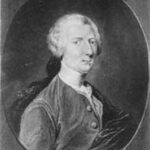
Conway wasn’t alone in the cabal. The Continental Army had suffered several defeats in the fall of 1777, and some members of Congress felt it was Washington’s leadership that was to blame. Conway began writing letters to prominent leaders, including General Horatio Gates, that were critical of Washington. After Washington got wind of Conway’s letter to General Gates, he wrote his own letter to Congress in January 1778. Conway was embarrassed, and in March 1778, he offered his resignation as an apology. Nevertheless, he was surprised and humiliated when Congress accepted. After General John Cadwalader wounded him in a duel defending Washington’s honor, Conway returned to France, where he died in exile in 1800…unable to recover his dignity after the horrific Conway Cabal.
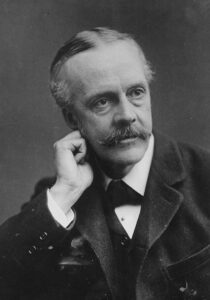 For a number of years Israel had no place to call home. That sounds like a strange thing, but for the nation of Israel, it was not a new thing. Biblical history tells us of a number of times that Israel’s God-given land was taken from them for a time, and they were taken into captivity. Even after the captivity the Jewish people were displaced from their promised land. They were also persecuted and subject to racial discrimination.
For a number of years Israel had no place to call home. That sounds like a strange thing, but for the nation of Israel, it was not a new thing. Biblical history tells us of a number of times that Israel’s God-given land was taken from them for a time, and they were taken into captivity. Even after the captivity the Jewish people were displaced from their promised land. They were also persecuted and subject to racial discrimination.
That began to change when on November 2, 1917, Foreign Secretary Arthur James Balfour wrote an important letter to Britain’s most illustrious Jewish citizen, Baron Lionel Walter Rothschild, expressing the British government’s support for a Jewish homeland in Palestine. I can only imagine how the Baron felt. This was like having someone offer you the moon. It was something the Jew never thought they would see again. Many didn’t think they would live long enough to see it. The letter would eventually become known as the Balfour Declaration, and it was the start of something good.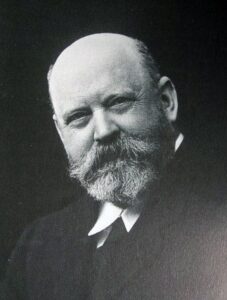
Because of concerns over the direction World War I was going, the British were very supportive of the Zionist movement. Lloyd George among others, held a genuine belief in the righteousness of Zionism, but Britain’s leaders also hoped that a statement supporting Zionism would help gain Jewish support for the Allies. On November 2, Balfour sent his letter to Baron Rothschild, who was a prominent Zionist and a friend of Chaim Weizmann, stating that: “His Majesty’s Government view with favor the establishment in Palestine of a national home for the Jewish people.”
The influence of the Balfour Declaration on the course of post-war events was immediate: According to the “mandate” system created by the Versailles Treaty of 1919, Britain was entrusted with the administration of Palestine, with the understanding that it would work on behalf of both its Jewish and Arab inhabitants. In 1948, the Balfour Declaration was scheduled to expire and Great Britain would no longer rule Palestine. The future of the Jewish people was at stake. The question over what to do with the 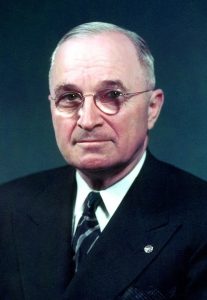 turbulent country was turned over to the United Nations. They, at the insistence of President Harry Truman, eventually decided to create the new country of Israel, specifically as a promised homeland for Jewish people. The new country was to be located across the various holy locations in which many events of the Old Testament occurred. The Jewish people were back in the promised land.
turbulent country was turned over to the United Nations. They, at the insistence of President Harry Truman, eventually decided to create the new country of Israel, specifically as a promised homeland for Jewish people. The new country was to be located across the various holy locations in which many events of the Old Testament occurred. The Jewish people were back in the promised land.
That was when United States President Harry Truman became the first world leader to officially recognize Israel as a legitimate Jewish state. On May 14, 1948, only eleven minutes after its creation the decree was delivered. His decision came after much discussion and advice from the White House staff, all of whom had differing viewpoints. Some advisors felt that creating a Jewish state was the only proper response to the Holocaust and would benefit American interests. Others took the opposite view, concerned about that the creation of a Jewish state would create more conflict in an already tumultuous region. No matter what happens, it was the right thing to do.
 I suppose that if I lived in Quebec, Canada, I might have heard the Abitibi-Témiscamingue region and maybe even the Western Quebec Seismic Zone. Since I don’t, these areas are new to me. Maybe they were new to a lot of people, but on November 1, 1935, a lot more people knew about them. On that day, a 6.1 magnitude earthquake with a maximum Mercalli intensity of VII (Very strong) occurred. The epicenter occurred on a thrust fault in the Timiskaming Graben, a little over 6 miles northeast of Témiscamingue, at about 1:03am ET.
I suppose that if I lived in Quebec, Canada, I might have heard the Abitibi-Témiscamingue region and maybe even the Western Quebec Seismic Zone. Since I don’t, these areas are new to me. Maybe they were new to a lot of people, but on November 1, 1935, a lot more people knew about them. On that day, a 6.1 magnitude earthquake with a maximum Mercalli intensity of VII (Very strong) occurred. The epicenter occurred on a thrust fault in the Timiskaming Graben, a little over 6 miles northeast of Témiscamingue, at about 1:03am ET.
While the earthquake was in Canada, it was felt over a wide area of North America, extending west to Fort William (now Thunder Bay), east to Fredericton, New Brunswick, north to James Bay and south as far as Kentucky and West Virginia. Occasional aftershocks were reported for several months. That seems extreme for a 6.1 magnitude earthquake, but I suppose it’s all in the connections. Fault lines aren’t just in a small area, they run for hundreds and even thousands of miles.
The most significant damage from the earthquake, both in the immediate area and as far south as North Bay and Mattawa, was to chimneys. In fact, 80% of the chimneys in that area were destroyed. A railroad embankment near Parent, which is 186 miles away, also collapsed. It looked like the embankment slide was already imminent, but the quake vibrated the last holds loose. There were some rockfalls and structural cracks reported as well. Thankfully, there were few major structural collapses aside from the Parent embankment. The 
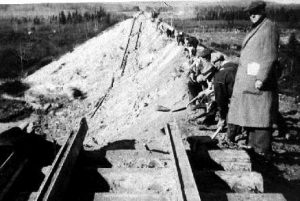 sparseness of the area’s population played a big part in the relative lack of major damage, despite the fact that it was a strong earthquake. The water of Tee Lake, close to the epicenter was discolored by the earthquake…due to a stirring up of gyttja, which is freshwater mud with abundant organic matter, rather than silt input from tributary streams. The relative lack of major damage, despite the fact that it was a strong earthquake, has been attributed primarily to the sparseness of the area’s population.
sparseness of the area’s population played a big part in the relative lack of major damage, despite the fact that it was a strong earthquake. The water of Tee Lake, close to the epicenter was discolored by the earthquake…due to a stirring up of gyttja, which is freshwater mud with abundant organic matter, rather than silt input from tributary streams. The relative lack of major damage, despite the fact that it was a strong earthquake, has been attributed primarily to the sparseness of the area’s population.
 When the nations of North and South Korea were split, it was much like when Germany became East and West Germany…people were caught in the crossfire…so to speak. Despite being unified off and on for nearly 1,500 years, the Korean peninsula was divided into North and South as a result of the breakup of the Japanese empire at the end of World War II. The United States government knew that it would have to administer the Philippines, as well as Japan itself. It was a big job, so the United States was reluctant to also take trusteeship of Korea. Basically, Korea just wasn’t a very high priority for the United States. The Soviets, on the other hand, were more than willing to step in and take control of lands that the Tsar’s government had relinquished its claim to after the Russo-Japanese War (1904–05).
When the nations of North and South Korea were split, it was much like when Germany became East and West Germany…people were caught in the crossfire…so to speak. Despite being unified off and on for nearly 1,500 years, the Korean peninsula was divided into North and South as a result of the breakup of the Japanese empire at the end of World War II. The United States government knew that it would have to administer the Philippines, as well as Japan itself. It was a big job, so the United States was reluctant to also take trusteeship of Korea. Basically, Korea just wasn’t a very high priority for the United States. The Soviets, on the other hand, were more than willing to step in and take control of lands that the Tsar’s government had relinquished its claim to after the Russo-Japanese War (1904–05).
The Soviets wanted to set the country up as communist, and the United States wanted the country to be capitalist. The sad truth about the difference between communism and capitalism is that capitalism is about freedom, and communism is about slavery. The country was divided along the 38th parallel with a demilitarized zone along that line. The North Korean side of the 38th Parallel was ruled by communism, and the South was ruled by Capitalism. The economic impact was most unfortunate, in that two separate and “necessary to each other” industrial areas were now on  opposite sides. The two countries were now both poor.
opposite sides. The two countries were now both poor.
That was a sad state of affairs, but the worse state of affairs was what happened to the people. Communism being what is was, worried that if the people were allowed to cross the borders freely, they would not come back, and they were probably right. So the people who lived in North Korea and had family in South Korea were no separated from each other, and those in the south were equally separated from loved ones. It is a horrible situation, but there seemed to be no remedy for it. The separation went on for many years. Finally on October 31, 2010, the North Korean government relented to a degree. Four hundred and thirty-six South Koreans were allowed to spend three days in North Korea to meet their 97 North Korean relatives, whom they had been separated from since the 1950-1953 war. The three-day reunion was wonderful, but also bittersweet, because it was followed by a sad goodbye. The separation had been excruciating, and they had no recourse. They were at  the mercy of the ruling government. Nevertheless, they were also thankful for the time to spend together, even if it meant a tearful goodbye following a luncheon meeting during inter-Korean temporary family reunions at Mount Kumgang resort.
the mercy of the ruling government. Nevertheless, they were also thankful for the time to spend together, even if it meant a tearful goodbye following a luncheon meeting during inter-Korean temporary family reunions at Mount Kumgang resort.
When you look at the realities of Socialism, Marxism, and Communism, you cannot really be surprised by the many people who are trying to escape from it’s grip. Most are willing to give their life to get out in the hope of giving their children a better life than that. Many lessons could be learned from the situation between North and South Korea, if we will only pay attention.
 I like lighthouses. That is just a fact. I am particularly fascinated with unusual lighthouse. There are many lighthouses all over the world. They are, of course, used to direct ships away from shallow waters or dangerous rocks that lurk below the surface of the water. Today, there are more than 21,600 lighthouses worldwide, and there are a few that are still in use. In pre-GPS days, they played a vital role in the shipping industry, but these days they are usually used as tourist attractions. Many are privately owned, and are only used in an extreme emergency, when the electronic guidance systems are down. Some lighthouses are simply abandoned. I have mixed feelings about those, because when abandoned, they usually fall into disrepair, but there is something about abandoned buildings that has always intrigued me…even when they have fallen into disrepair.
I like lighthouses. That is just a fact. I am particularly fascinated with unusual lighthouse. There are many lighthouses all over the world. They are, of course, used to direct ships away from shallow waters or dangerous rocks that lurk below the surface of the water. Today, there are more than 21,600 lighthouses worldwide, and there are a few that are still in use. In pre-GPS days, they played a vital role in the shipping industry, but these days they are usually used as tourist attractions. Many are privately owned, and are only used in an extreme emergency, when the electronic guidance systems are down. Some lighthouses are simply abandoned. I have mixed feelings about those, because when abandoned, they usually fall into disrepair, but there is something about abandoned buildings that has always intrigued me…even when they have fallen into disrepair.
One such unusual, abandoned lighthouse is the Aniva Lighthouse in Sakhalin, Russia. The lighthouse is situated on a small rock called Sivuchya near the rocky Cape Aniva. It is difficult to reach, and can only be accessed by water. To make matters worse, the tides are strong there. Still, the breathtaking scenery makes the journey worth while. Construction started on Aniva Lighthouse in June 1937 and finished in October 1939, taking just over two years. Building this navigational structure was difficult: all of the construction materials had to be delivered by water. Severe weather conditions didn’t make the process any easier.
When I first saw a picture on the Aniva Lighthouse, it reminded me of the front of a ship. It almost looked like a 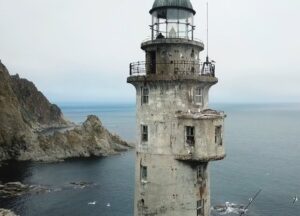 shipwreck, except for the lighthouse part, of course. Upon closer inspection, the lighthouse really doesn’t look like a ship at all, but maybe it was designed to give that illusion. The concrete tower, is painted to match the surrounding rocks, its stroboscopic lamp located 131 above the ground. The structure is round in shape and equipped with a bay window, the 9-floor tower stands on an oval base, which looks like it is coming out of the coastal rocks. Maybe that’s why it looks like a ship.
shipwreck, except for the lighthouse part, of course. Upon closer inspection, the lighthouse really doesn’t look like a ship at all, but maybe it was designed to give that illusion. The concrete tower, is painted to match the surrounding rocks, its stroboscopic lamp located 131 above the ground. The structure is round in shape and equipped with a bay window, the 9-floor tower stands on an oval base, which looks like it is coming out of the coastal rocks. Maybe that’s why it looks like a ship.
The Aniva Lighthouse was well equipped for living, no matter what the weather conditions. The basement was equipped with diesel engines and batteries. The kitchen was located on the ground floor along with the food storage The radio room, equipment room, and watch room were situated on the second floor of the lighthouse. As many as 12 people could be accommodated in the living quarters, located on the third, fourth and fifth floors, with each floor having a separate room. The interior of the quarters was modest, housing two bunk beds and small alcoves for personal belongings. Much of the light came in through small porthole windows. The storeroom was on the sixth floor. The seventh floor housed the mechanisms of a pneumatic siren, with its horn installed directly on the roof of the bay window. The eighth floor was used for fuel storage. The ninth floor housed the lens rotation mechanism of the lighthouse. The lantern rotated inside a bowl with about 660 pounds of mercury. The stroboscopic lamp was set in motion by a mechanism similar to a clockwork. Running through 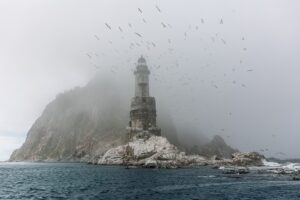 the center of a spiral staircase leading to the very top of the tower, was a pipe with a suspended weight of 595 pounds inside. It took the weight three hours to reach the bottom, rotating the lamp in the process. After that, the lighthouse keeper had to rewind the system. The lighthouse had a range of 17.5 miles. That must have been a job.
the center of a spiral staircase leading to the very top of the tower, was a pipe with a suspended weight of 595 pounds inside. It took the weight three hours to reach the bottom, rotating the lamp in the process. After that, the lighthouse keeper had to rewind the system. The lighthouse had a range of 17.5 miles. That must have been a job.
It was decided to make the Aniva Lighthouse autonomous by re-equipping it to work from a nuclear power source in the 1990s. In 2006, the radioisotope generators were removed. The lighthouse has been abandoned ever since. These days it is a haven for the birds.
 My Aunt Sandy Pattan is the family history guru in the Byer family. As a child, she was sickly, and so spent a lot of time in bed. Being home from school, just Aunt Sandy and her mom, my grandma, Hattie Byer, gave them much time to sit and talk. Remember that while television did exist, it was not common in most homes, and I don’t believe that my grandparents had one when the kids were growing up. There were too many other things that the family needed in the home, like food, for example. Video games were not invented yet, so Aunt Sandy was left with books, and Grandma’s stories to entertain her through the hours over recuperating from this cold or that flu, which seemed to attack her often.
My Aunt Sandy Pattan is the family history guru in the Byer family. As a child, she was sickly, and so spent a lot of time in bed. Being home from school, just Aunt Sandy and her mom, my grandma, Hattie Byer, gave them much time to sit and talk. Remember that while television did exist, it was not common in most homes, and I don’t believe that my grandparents had one when the kids were growing up. There were too many other things that the family needed in the home, like food, for example. Video games were not invented yet, so Aunt Sandy was left with books, and Grandma’s stories to entertain her through the hours over recuperating from this cold or that flu, which seemed to attack her often.
My grandmother grew up in the early 1900s, and by the time Aunt Sandy came along in 1945, Grandma and Grandpa had eight other children. Aunt Sandy would be their last child. While Grandma and Grandpa disagreed on her name, Grandpa honored their decision to let the older kids decide between Sonya and Sandra. He was an honorable man. Grandma told her youngest child about a time when the Indians 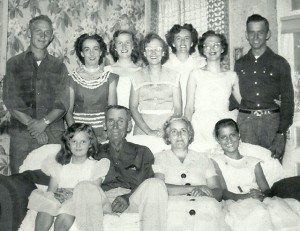 being around, wasn’t all that unusual. Many of her stories might have come from her parents and in-laws tales, but she remembered them all, and passed them on to her daughter, who absorbed them like a sponge. I recall my history classes in school, filled with dry boring date memorization, but when history is told like the story it is, it is amazingly interesting. That’s how Aunt Sandy got to learn history…or shall I say really learn history. When you think about an Indian who spends hours sitting on his horse looking at the wife of a respected friend, because he thought she was beautiful, and still never disrespecting her, because she was the wife of his friend, and you know that the woman was your grandmother, you can begin to relate to history as a story.
being around, wasn’t all that unusual. Many of her stories might have come from her parents and in-laws tales, but she remembered them all, and passed them on to her daughter, who absorbed them like a sponge. I recall my history classes in school, filled with dry boring date memorization, but when history is told like the story it is, it is amazingly interesting. That’s how Aunt Sandy got to learn history…or shall I say really learn history. When you think about an Indian who spends hours sitting on his horse looking at the wife of a respected friend, because he thought she was beautiful, and still never disrespecting her, because she was the wife of his friend, and you know that the woman was your grandmother, you can begin to relate to history as a story.
Aunt Sandy has never lost her love of history, and especially family history. Her parents came from large families and then went on to have a large family, so there was a lot of interesting activities. From the days of gunslingers to the first planes, cars, television, and so many other inventions, her parents had seen it all…or at least heard all about it. The events of history are so amazing, that the current days seem to pale in 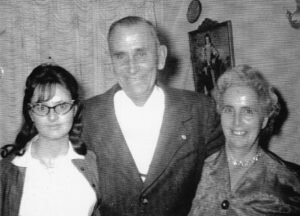 comparison. I now that my Aunt Sandy loved hearing all the family stories as they were passed down from mother to daughter, and I’m sure that she thought her family was the most amazing on in history, but the reality is that they were probably just a normal, every day, run of the mill families, living their life in the normal way for the times. It’s just that to the hearer of the story of history, it is so far back in time, and so unusual compared to today’s world, that it seems almost far-fetched, except that it isn’t. It’s the true story of history, and like Aunt Sandy, I will always be grateful to be the one the stories are told to. Today is Aunt Sandy’s birthday. Happy birthday Aunt Sandy!! Have a great day!! We love you!!
comparison. I now that my Aunt Sandy loved hearing all the family stories as they were passed down from mother to daughter, and I’m sure that she thought her family was the most amazing on in history, but the reality is that they were probably just a normal, every day, run of the mill families, living their life in the normal way for the times. It’s just that to the hearer of the story of history, it is so far back in time, and so unusual compared to today’s world, that it seems almost far-fetched, except that it isn’t. It’s the true story of history, and like Aunt Sandy, I will always be grateful to be the one the stories are told to. Today is Aunt Sandy’s birthday. Happy birthday Aunt Sandy!! Have a great day!! We love you!!
 Salar de Uyuni (or Salar de Tunupa) is not a place that most of us living in the United States would have heard of, unless we are a world traveler or an avid travel reader, that is. Salar de Uyuni is the world’s largest salt flat, or playa, at over 3,900 square miles in area. A playa is defined as a the flat-floored bottom of an undrained desert basin that becomes at times a shallow lake. Salar de Uyuni is in the Daniel Campos Province in Potosí in southwest Bolivia, probable the main reason we may not have heard of it before. Salar is near the crest of the Andes at an elevation of 11,995 feet above sea level.
Salar de Uyuni (or Salar de Tunupa) is not a place that most of us living in the United States would have heard of, unless we are a world traveler or an avid travel reader, that is. Salar de Uyuni is the world’s largest salt flat, or playa, at over 3,900 square miles in area. A playa is defined as a the flat-floored bottom of an undrained desert basin that becomes at times a shallow lake. Salar de Uyuni is in the Daniel Campos Province in Potosí in southwest Bolivia, probable the main reason we may not have heard of it before. Salar is near the crest of the Andes at an elevation of 11,995 feet above sea level.
The Salar de Uyuni is a strange, sometimes lake/sometimes desert that was formed as a result of transformations between several prehistoric lakes that existed around forty thousand years ago, but had all evaporated over time. The area has a large salt content, creating a flat that is now  covered by a few meters of salt crust. The area is amazingly flat with the average elevation variations within one meter over the entire area of the Salar. The crust serves as a source of salt and covers a pool of brine, which is exceptionally rich in lithium. The large area, clear skies, and exceptional flatness of the surface make the Salar de Uyuni ideal for calibrating the altimeters of Earth observation satellites. After it rains in the area, a thin layer of dead calm water transforms the flat into the world’s largest mirror, 80 miles across. Many people have photographed its amazing picturesque views.
covered by a few meters of salt crust. The area is amazingly flat with the average elevation variations within one meter over the entire area of the Salar. The crust serves as a source of salt and covers a pool of brine, which is exceptionally rich in lithium. The large area, clear skies, and exceptional flatness of the surface make the Salar de Uyuni ideal for calibrating the altimeters of Earth observation satellites. After it rains in the area, a thin layer of dead calm water transforms the flat into the world’s largest mirror, 80 miles across. Many people have photographed its amazing picturesque views.
The Salar is a prime breeding ground for several species of Flamingos, and also serves as the major transport route across the Bolivian Altiplano. Salar de Uyuni is also a climatological transitional zone since the towering tropical cumulus congestus and cumulonimbus incus clouds that form in the eastern part of the salt flat during the summer cannot permeate beyond its drier western edges, near the Chilean border and the Atacama Desert.  During the dry season, the water on the playa dries up, and forms crystalline formations as the salt dries out. During the wet season it becomes a shallow lake that reflects the sky beautifully.
During the dry season, the water on the playa dries up, and forms crystalline formations as the salt dries out. During the wet season it becomes a shallow lake that reflects the sky beautifully.
“Salar means salt flat in Spanish. Uyuni originates from the Aymara language and means a pen (enclosure); Uyuni is a surname and the name of a town that serves as a gateway for tourists visiting the Salar. Thus Salar de Uyuni can be loosely translated as a salt flat with enclosures, the latter possibly referring to the “islands” of the Salar; or as “salt-flat at Uyuni (the town named ‘pen for animals’)”.
 On the morning of October 21, 1966, a catastrophic collapse of a colliery spoil tip occurred on a mountain slope above the Welsh village of Aberfan, near Merthyr Tydfil. A spoil tip, also called a boney pile, culm bank, gob pile, waste tip, or…in Scotland, bing, is a pile built of accumulated spoil…waste material removed during mining. These waste materials are typically composed of shale, but they also contain smaller quantities of carboniferous sandstone and other residues. Spoil tips are not formed of slag, but in some areas, such as England and Wales, they are referred to as slag heaps. The area near Aberfan overlaid a natural spring, and a period of heavy rain led to a build-up of water within the tip which caused it to suddenly slide downhill as a slurry. The disaster killed 116 children and 28 adults, as it engulfed Pantglas Junior School and a row of houses. The accident left just five survivors and wiped out half the town’s youth. The Aberfan disaster became one of the United Kingdom’s worst coal mining accidents, but strangely it isn’t anything like a normal coal mining accident.
On the morning of October 21, 1966, a catastrophic collapse of a colliery spoil tip occurred on a mountain slope above the Welsh village of Aberfan, near Merthyr Tydfil. A spoil tip, also called a boney pile, culm bank, gob pile, waste tip, or…in Scotland, bing, is a pile built of accumulated spoil…waste material removed during mining. These waste materials are typically composed of shale, but they also contain smaller quantities of carboniferous sandstone and other residues. Spoil tips are not formed of slag, but in some areas, such as England and Wales, they are referred to as slag heaps. The area near Aberfan overlaid a natural spring, and a period of heavy rain led to a build-up of water within the tip which caused it to suddenly slide downhill as a slurry. The disaster killed 116 children and 28 adults, as it engulfed Pantglas Junior School and a row of houses. The accident left just five survivors and wiped out half the town’s youth. The Aberfan disaster became one of the United Kingdom’s worst coal mining accidents, but strangely it isn’t anything like a normal coal mining accident.
The colliery spoil tip was the responsibility of the National Coal Board (NCB), and the inquiry into the disaster placed the blame on the organization, also naming nine employees. When everything broke loose, the resulting landslide sent 140,000 cubic yards of coal waste in a tidal wave 40-feet high hurtling  down the mountainside where Merthyr Vale Colliery stood. The slide destroyed farmhouses, cottages, houses, and part of the neighboring County Secondary School. The avalanche is thought to have been the result of shoddy construction and a build-up of water in one of the colliery’s spoil tips…piles of waste material removed during mining.
down the mountainside where Merthyr Vale Colliery stood. The slide destroyed farmhouses, cottages, houses, and part of the neighboring County Secondary School. The avalanche is thought to have been the result of shoddy construction and a build-up of water in one of the colliery’s spoil tips…piles of waste material removed during mining.
Like many countries and areas, Wales was known for coal mining during the Industrial Revolution. Aberfan’s colliery opened in 1869. It didn’t take long for it to run out of space for waste, and by 1916 the space on the mountain valley floor was full. At that point, the colliery started “tipping” on the mountainside above the town. In 1966 it amassed seven tips containing 2.7 million cubic yards of colliery spoil.
Aberfan’s town council had contacted the National Coal Board to express concerns over the spoil tips years 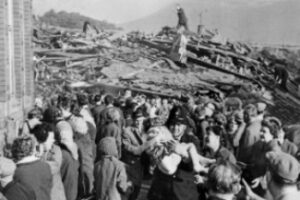 before the incident, following a non-lethal accident on the colliery. Unfortunately, they took no action at that time, and the issue was never addressed. The tip that fell on October 21 covered material that previously slipped. The disaster received widespread national attention. Queen Elizabeth II did not visit the site until eight days after the accident, and she admitted later that not going sooner was one of her biggest regrets. Once the disaster happened, little can be done to fix the matter, but the Mines and Quarries (Tips) Act was passed in 1969 to add provisions when using mining tips, among other things. Sadly it was too late for those lost, but it was good news for future miners and the surrounding towns.
before the incident, following a non-lethal accident on the colliery. Unfortunately, they took no action at that time, and the issue was never addressed. The tip that fell on October 21 covered material that previously slipped. The disaster received widespread national attention. Queen Elizabeth II did not visit the site until eight days after the accident, and she admitted later that not going sooner was one of her biggest regrets. Once the disaster happened, little can be done to fix the matter, but the Mines and Quarries (Tips) Act was passed in 1969 to add provisions when using mining tips, among other things. Sadly it was too late for those lost, but it was good news for future miners and the surrounding towns.
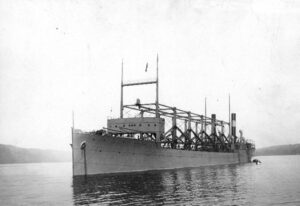 When a ship sinks, we expect to be able to find it, or at least find out where it went down. With radios, making it possible to receive a “May Day” call, we expect to be able to pinpoint the location of the floundering ship. Unfortunately, that isn’t always the case. Sometimes, no matter how hard we search for the ship, plane, and even car, but the search seems to be in vain. I think it is more common to have a search without success when it comes to a ship or even a plane in the ocean. It is so hard to see something that is so far below the surface. Still, it seems like after a century or more, there should be some breakthrough…shouldn’t there.
When a ship sinks, we expect to be able to find it, or at least find out where it went down. With radios, making it possible to receive a “May Day” call, we expect to be able to pinpoint the location of the floundering ship. Unfortunately, that isn’t always the case. Sometimes, no matter how hard we search for the ship, plane, and even car, but the search seems to be in vain. I think it is more common to have a search without success when it comes to a ship or even a plane in the ocean. It is so hard to see something that is so far below the surface. Still, it seems like after a century or more, there should be some breakthrough…shouldn’t there.
A 550-foot-long naval ship, USS Cyclops debuted in 1910. The ship was a bit of a jack-of-all-trades, so to speak…at least in it’s early days. It moved coal around the seas, as well as providing aid to refugees. Then, during World War I, USS Cyclops became a naval transporter. In 1918, the Cyclops, with it’s crew of 306 people and 11,000 tons of manganese, sailed from Brazil. The ship made a stop in Barbados and then sailed on toward Baltimore. Somewhere along the way, it disappeared. Strangely, there was no SOS made. It was as if the ocean had swallowed the ship up. Now one knew exactly where to look for it, because it had sailed quite a ways from its last known location. Maybe if there had been a distress call of any kind, they could have had a general location. Without that, they didn’t know if it had gone off course, or how fast it was traveling, so there was no way to be sure. It was thought that the Cyclops may have gone down in  the Puerto Rico Trench. The waters there run very deep, which would have made it very difficult to located the ship in 1918. Still, there was another hazardous area…the Bermuda Triangle, and some people thought that might be to blame.
the Puerto Rico Trench. The waters there run very deep, which would have made it very difficult to located the ship in 1918. Still, there was another hazardous area…the Bermuda Triangle, and some people thought that might be to blame.
The US Navy calls the tragedy of Cyclops, “The disappearance of this ship has been one of the most baffling mysteries in the annals of the Navy. All attempts to locate her have proved unsuccessful.” To this day, the original Cyclops has never been found. Many other ships that were lost at sea have been found, many that were lost before Cyclops, but there has been no sign of Cyclops. The mystery of Cyclops might never be solved, and considering the lives lost, that is very sad indeed.

